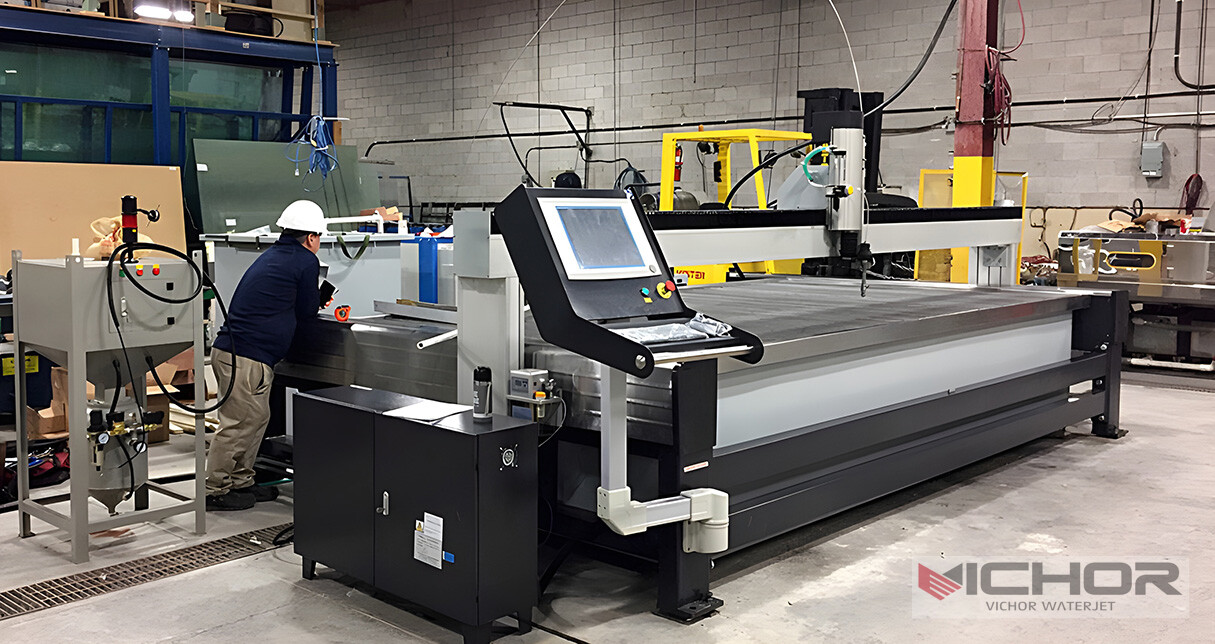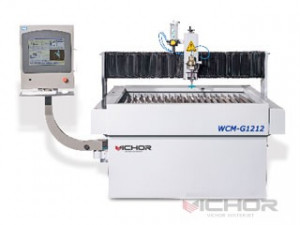
Table Top Water Jet Cutting Machine: Your Compact Powerhouse for Precision Cutting
In the dynamic world of manufacturing, prototyping, education, and bespoke fabrication, the demand for versatile, precise, and material-agnostic cutting solutions is ever-present. Enter the table top water jet cutting machine. This compact marvel brings the formidable power of abrasive water jet (AWJ) technology down to a benchtop scale, revolutionizing what’s possible in smaller workshops, labs, and studios. Offering unparalleled versatility without requiring industrial-scale footprints or budgets, these machines are democratizing high-precision cutting. This comprehensive guide delves into the essential aspects of the table top water jet cutting machine, exploring its capabilities, advantages, and why it might be the perfect addition to your creative or production arsenal.
1. Unmatched Precision and Intricate Cutting Capabilities
The core strength of any water jet cutter, including the table top water jet cutting machine, lies in its exceptional precision. Utilizing an ultra-high-pressure stream of water, often mixed with fine abrasive garnet, these machines produce a cutting tool measured in thousandths of an inch (typically 0.030″ to 0.050″ / 0.76mm to 1.27mm kerf width). This translates to:
Microscopic Accuracy: Capable of holding tolerances as tight as +/- 0.001″ to +/- 0.005″ (0.025mm to 0.127mm) depending on machine calibration, material, and thickness. This is crucial for intricate parts, fine details, and assemblies requiring perfect fit.
Complex Geometries Made Easy: Unlike many other cutting methods restricted by tool geometry or heat, a table top water jet cutting machine effortlessly handles sharp inside corners, complex curves, delicate patterns, and fine text with zero tool wear concerns. CAD designs translate directly into cut parts.
Near-Zero Heat Affected Zone (HAZ): The cold-cutting nature of water jet technology means no thermal distortion, hardening, or micro-cracking along the cut edges. This preserves the material’s original properties and structural integrity, essential for metals, composites, and sensitive materials.
Burr-Free Edges: Water jet cutting typically produces smooth edges with minimal secondary finishing required, especially on softer materials. Harder materials may have a slight textured finish, but it’s generally far superior to thermal cutting methods.
2. Unrivaled Material Versatility: Cut (Almost) Anything
Perhaps the most compelling feature of a table top water jet cutting machine is its astonishing material versatility. It cuts materials based on erosion, not melting or fracturing, making it uniquely capable across a vast spectrum:
Metals: Stainless steel, aluminum, titanium, brass, copper, tool steel, mild steel (thickness capacity varies by machine power).
Plastics & Composites: Acrylic (PMMA), polycarbonate, PVC, ABS, Delrin, G10/FR4, carbon fiber, fiberglass, laminates.
Stone, Tile & Glass: Granite, marble, slate, ceramic tile, porcelain, glass (including laminated). Ideal for intricate mosaics, sinks, and decorative elements.
Rubber & Foam: EPDM, neoprene, silicone, polyurethane foam, EPS, XPS – cleanly and without compression.
Exotic Materials: Kevlar, titanium, Inconel (within thickness limits), circuit boards, honeycomb structures, food products (pure water jet).
Table 1: Common Material Compatibility for Table Top Water Jet Machines
| Material Category | Examples | Pure Water Jet? | Abrasive Water Jet? | Notes |
|---|---|---|---|---|
| Metals | Aluminum, Stainless Steel, Titanium, Brass | No | Yes | Thickness limited by machine pressure (<1″ typical) |
| Plastics | Acrylic, PVC, Polycarbonate, ABS | Yes | Yes | Pure water for soft plastics; abrasive for harder |
| Composites | Carbon Fiber, Fiberglass, G10 | No | Yes | Clean cuts, minimal delamination |
| Stone & Tile | Granite, Marble, Slate, Ceramic | No | Yes | Excellent for detailed inlays and shapes |
| Glass | Float Glass, Tempered (edges), Laminated | Yes (thin) | Yes (thick) | Pure water for scoring/thin cuts; abrasive for thicker |
| Rubber & Foam | Neoprene, EPDM, Silicone, PU Foam | Yes | Optional | Clean, fast cuts without melting or compression |
| Specialty | Circuit Boards, Honeycomb, Leather, Food | Yes or Yes | Depends | Pure water for soft organics; abrasive for harder |
3. Compact Footprint and Accessibility
The defining characteristic separating a table top water jet cutting machine from its industrial counterparts is its size and accessibility:
Benchtop Operation: Designed to fit on sturdy workbenches or dedicated stands within standard workshops, classrooms, R&D labs, or even larger studios. This eliminates the need for massive factory floor space.
Simplified Infrastructure: While still requiring a high-pressure pump (often integrated into a cabinet beneath the table), modern table top water jet cutting machine models are designed with smaller facilities in mind. They typically require less demanding electrical service (often standard 220V single-phase or 480V 3-phase) and have integrated water recycling/catch tank systems, minimizing plumbing complexity compared to huge industrial tanks. Noise levels are also generally lower.
Operator-Friendly Design: Controls are typically intuitive CNC interfaces (touchscreens are common), making programming and operation accessible to technicians, artisans, and educators without highly specialized water jet training. Safety features (enclosures, interlocks) are integrated.
Lower Barrier to Entry: While still a significant investment, the cost of a table top water jet cutting machine is substantially lower than a full-scale industrial system, making the technology feasible for small businesses, universities, makerspaces, and job shops that couldn’t previously justify water jet capabilities.
4. Operational Considerations and Safety
Operating a table top water jet cutting machine requires understanding its unique aspects:
The High-Pressure Heart: The core is the ultra-high-pressure intensifier pump, generating pressures from 40,000 PSI (2,750 bar) up to 90,000 PSI (6,200 bar) or more on advanced models. This demands respect for maintenance schedules (seals, filters) and adherence to strict safety protocols. Never bypass safety interlocks on the enclosure.
Abrasive Handling: Abrasive cutting involves storing, feeding, and managing garnet abrasive. Machines have integrated systems, but operators need to handle garnet bags and manage spent abrasive disposal (often collected in a sludge tank). Dust control during loading is important.
Water Management: The cutting process generates a slurry of water, abrasive, and cut material particles. Table top water jet cutting machine units incorporate catch tanks and often filtration/recycling systems to minimize water consumption and waste. Regular tank cleaning is necessary.
Cutting Speed vs. Precision: Water jet cutting is precise but not always the fastest method. Cutting speed depends heavily on material type, thickness, desired edge quality, and pump pressure. Thicker, harder materials cut slower. A table top water jet cutting machine excels in intricate work and material versatility rather than high-volume production speed.
Noise and Splash: While enclosures mitigate this, operation involves significant noise from the high-pressure pump and cutting head, and splash within the tank. Hearing protection is recommended near the machine during operation.
5. Cost Analysis: Investment and Operational Economics
Understanding the financial implications is key when considering a table top water jet cutting machine:
Capital Investment: Prices range widely based on build quality, cutting area size, maximum pressure, and features. Expect entry-level models from $60,000-$100,000+, scaling to $150,000+ for larger or higher-pressure benchtop models. This is a fraction of the $200,000-$500,000+ for large industrial systems.
Operational Costs (Per Hour):
Electricity: The high-pressure pump is the primary consumer.
Abrasive (Garnet): This is often the largest recurring cost. Consumption depends on orifice size, pressure, and cutting time.
Water: Consumption is relatively low due to recycling, but filtration media add cost.
Maintenance: Regular replacement of high-wear components: intensifier pump seals, cutting head orifices (very small sapphire or diamond jewels), mixing tubes (carbide or ceramic), filters. Planned maintenance is crucial for uptime.
Labor: Operator time for programming, setup, and machine tending.
Cost Per Part: While machine time costs are higher than some methods (like laser for thin metals), the elimination of secondary operations (minimal deburring, no stress relief needed), reduced material waste due to nesting efficiency, and the ability to cut expensive or difficult materials at all often makes water jet highly economical for complex, low-to-medium volume parts or prototypes.
ROI Justification: The ROI hinges on the value derived from its unique capabilities: complex part fabrication in-house, rapid prototyping across diverse materials, eliminating outsourcing costs and lead times, offering unique services, and educational/research value.
6. Key Applications: Where the Table Top Water Jet Shines
The table top water jet cutting machine finds diverse applications across numerous fields:
Prototyping & R&D: Rapidly iterate complex metal, plastic, and composite parts without tooling. Test designs in the final material.
Custom Fabrication & Job Shops: Produce bespoke parts, signage, architectural elements (metal grilles, stone inlays), gaskets, spacers, and intricate components for clients.
Aerospace & Defense (Small Parts): Manufacture precision components from titanium, aluminum, and composites for drones, satellites, and instrumentation.
Electronics: Cut complex enclosures, heatsinks, insulators (G10/FR4), and prototype circuit boards.
Art & Design: Create intricate sculptures, detailed metal artwork, decorative tiles, complex patterns in stone/glass, and custom jewelry masters.
Education (Universities, Tech Schools): Provide hands-on learning for engineering, manufacturing, and design students with industrial-grade technology in a manageable size.
Automotive (Aftermarket & Prototyping): Create custom brackets, interior components, lightweight panels, and prototype parts.
Medical Device Manufacturing: Prototype and produce components from biocompatible metals and plastics.
7. Choosing the Right Table Top Water Jet: Key Considerations
Selecting the optimal table top water jet cutting machine requires careful evaluation:
Cutting Envelope (X, Y, Z): Determine the maximum part size you need to accommodate. Common sizes range from 2’x2′ up to 4’x8′ or larger on premium benchtops.
Maximum Pump Pressure: Higher pressure (e.g., 60k, 87k, 90k+ PSI) enables faster cutting speeds and the ability to cut thicker/harder materials. Balance needs with budget.
Machine Rigidity & Accuracy: Look for robust construction (granite or precision-machined metal bases), high-quality linear guides, and servo motors for positioning accuracy and repeatability.
Control System & Software: User-friendly CNC interface, compatibility with standard CAD/CAM software (or included proprietary software), nesting capabilities, and ease of programming are crucial.
Abrasive Delivery System: Reliable, consistent abrasive metering is essential for cut quality. Understand the system type and maintenance needs.
Tank System & Filtration: Assess the ease of access for loading/unloading parts, water capacity, filtration efficiency (for recycling), and sludge management.
Service & Support: Reputable manufacturer/dealer support, availability of spare parts, and technician training are vital for minimizing downtime. Consider warranty terms.
Safety Features: Ensure robust enclosure, safety interlocks, and pressure relief systems.
Future Trends: The Evolving Table Top Water Jet
The table top water jet cutting machine market continues to innovate:
Increased Power Density: Higher pressure pumps (90k+ PSI) becoming more accessible in compact formats for better performance.
Enhanced Automation: Integration of automatic abrasive loading, simpler tank cleaning systems, and even basic robotic part loading/unloading for lights-out operation.
Smarter Controls: AI-powered features for optimizing cutting paths, predicting maintenance needs, and simplifying operation.
Improved Sustainability: More efficient water recycling, garnet reclamation technologies, and energy-saving pump designs.
Hybrid Add-Ons: Exploration of combining water jet cutting heads with other tools (like drills) on the same compact platform.
The table top water jet cutting machine stands as a transformative technology, bringing industrial-grade precision and unmatched material versatility within reach of smaller operations. By eliminating the heat and mechanical stress inherent in other cutting methods, it delivers superior edge quality and preserves material properties across metals, plastics, stone, composites, glass, and more. Its compact footprint and relatively lower barrier to entry compared to massive industrial systems open doors for innovation in prototyping, custom fabrication, education, and specialized manufacturing. While operational costs like abrasive garnet require management, the ability to handle complex geometries in diverse materials, reduce secondary operations, and bring production capabilities in-house often delivers a compelling return on investment. For any workshop, lab, or business seeking the ultimate in cold-cutting precision and flexibility without an industrial footprint, investing in a robust table top water jet cutting machine is a strategic step towards unlocking new levels of creativity and production capability. It truly is a compact powerhouse.
continue reading
Related Posts
- 1371 words6.9 min read
- 1449 words7.3 min read




